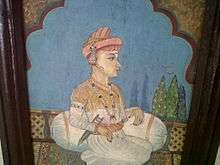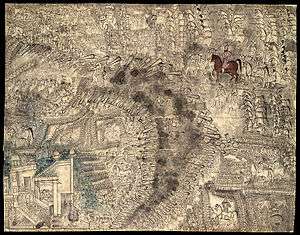Vishwasrao
Shrimant Vishwasrao Peshwa (March 7, 1741 – January 14, 1761) was the eldest son of Balaji Baji Rao Bhat, Peshwa of Pune of the Maratha Empire and also was the heir to the title of Peshwa of the Maratha Empire. Shrimant Vishwasrao had received training in administration and warfare from the age of 8 years old. He had impressed the Maratha infantry by his performance at Sindkheda and Udgir battle 1760. His specialty was Bow and Arrow or Dhanur-vidya along with sword fighting. During Battle of Udgir, he was unstoppable with the bow and arrow while mounted on an war-elephant Vishwasrao was tall and well-built following the genetic constitution of the Peshwa family. Although, he looked exactly like the younger version of his grandfather Peshwa Bajirao , Vishwasrao had blue eyes. As per Sardesai and few other authors that named him the most handsome among the Peshwa men, Vishwasrao followed a strenuous gym routine and performed Kawaiti ( army training on a regular basis). Kaustubh Kasture states in his book, "Sakalraj Karya Dhurandar Sadashivrao Bhausaheb" that Sadashivrao saw that Vishwasrao received thorough military and administration training. It is believed as per some sources, it was Nanasaheb Peshwa who introduced regular army training and added the best armour to the Maratha army.[1]
Shrimant Vishwasrao Peshwa | |
|---|---|
 | |
| Born | 7 March 1741 Shaniwarwada, Pune, Maratha Empire |
| Died | 14 January 1761 (aged 19) Panipat |
| Allegiance | Maratha Empire |
| Battles/wars | Third Battle of Panipat |
| Spouse(s) | Radhikabai Gupte |
| Relations | Madhavrao I (Brother) Narayan Rao (Brother) Sadashivrao Bhau (Uncle) Raghunathrao (Uncle) Shamsher Bahadur I (Uncle) Baji Rao I(Grandfather) Kashibai(Grandmother) |
He got hit in the head by a shot fired by a Pashtun officer during the period of the most intense fighting (Approx. between 01:00 PM and 02:30 PM) at Third Battle of Panipat.[2] He died fighting on the front lines. Marathas were winning the battle but some contingents charged ahead of their cue and obstructed the cannon liness creating a problem for Ibrahim Khan Gardi at aiming for the enemies. As per Grant Duff, upon hearing about Shrimant Vishwasrao's death Malharrao Holkar retreated from the field with at least 10,000 soldiers and sardars. He also took men of significance like Damaji Gaekwad with him. He went to Delhi and asked people of significance like Vinchurkar to vacate Delhi.
Although Vishwas Rao Bhat was first exposed to actual warfare at Sindkheda near Hyderabad, against Nizam in 1756, he was the nominal Commander of Maratha Forces and the Peshwa's representative during Third Battle of Panipat under guidance of his uncle Sadashivrao Bhau.
At the time of the battle, the Maratha Empire was in control of about two-thirds of the Indian subcontinent (including areas of the modern Republic of India and Pakistan.
Early life
Vishwasrao was born as the eldest son of Balaji Baji Rao at Supe near Pune (Supe was the Jagir of Shahaji near Pune). He was trained in Administrative matters and was exposed to Military training early in his life. Viswasrao had inherited the looks of his grandfather Bajirao and had even exceeded his charm. G. S. Sardesai writes that none was there with more handsome-looks in Peshwa lineage than this Viswas Rao. Raghunath Yadav author of one of the Panipat Bakhar had stated “पुरुषात देखणा विश्वासराव" ("The one most handsome among all men Vishwasrao. ) [3]
Engagement
Vishwasrao was engaged to Radhikabai who was daughter of Sardar Sakharam Hari Gupte of Nashik. She was the niece of Parvatibai, the wife of Sadashivrao and her marriage was fixed by Chhatrapati Shahuji I.[4] [5][6]

Death
Shrimant Vishwasrao had sensed that there could be a debacle on the final day of battle although Abdali was receding. There was no food and Sadashivrao, Parvatibai and Vishwasrao were pretending to be on a fast taking the moral responsibility. Meanwhile, they were trying to make food available to the soldiers. Shrimant Jankoji Shinde urged him to write a letter to Nanasaheb Peshwa asking for help. Worrying, that he wouldn't let his ever victorious and righteous uncle Sadashivrao lose his streak in front of the gilchas, Vishwasrao wrote a letter to Nanasaheb. In that letter he urged Nanasaheb to bring in more soldiers, money and food to help Bhausaheb. Shrimant Vishwasrao wrote that his own life was not important as Nanasaheb had two more sons. However, if he were to lose a brother and the nation a patriotic leader like Bhausaheb then that loss would be irreparable. His fears came out to be true as due to some deceit, Najib Khan, Abdali's friend and Malharrao Holkar's foster son was able to murder Mehendale while he was returning victorious from a skirmish prior to the battle. Bhausaheb was at a personal loss and without a commander. During the battle of Udgir, Shrimant Vishwasrao had established himself as the rising valorous Maratha leader. He successfully led the troops and fought alongside Shrimant Jankoji Shinde. The two were very close friends. Even the valorous Tukoji and Mahadji Shinde were having faith in their captain, Bhausaheb. They had vowed to fight till their last breath. Trusting, his fiercely loyal and able young team, he made Vishwasrao a commander in the Third Battle of Panipat. On the final day, Shrimant Vishwasrao went to the battlefield with no morsel of food relying only on sugared water like the rest of the Maratha warriors. He fought valiantly by his uncle's side killing many gilchas and creating a thunder in the opposing camp. While he was fiercely fighting on the front lines, as he was hit by an arrow on his shoulder, a shot hit his head while he was lying down, injured.[8]
In popular culture
- In the 1994 Hindi TV series The Great Maratha, Vishwasrao's character was portrayed by Sanjay Sharma.
See also
- Maratha Empire
- Peshwe
- Bhat family
- Maratha emperors
References
- http://ketkardnyankosh.com/index.php/2012-09-06-10-45-30/10573-2013-03-05-07-25-35
- See Rawlinson (1926), Account of the last Battle of Panipat, Oxford UP, np. And also D R Lal, 'Third Battle of Panipat- an historical account' Lahore: FC College Press, 1932, p 174. Lal states citing contemporary Afghan sources that the officer in question was probably one Bahadar Khan Tarin, aa
- Abhas Verma, "Third Battle of Panipat", Bhartiya Kala Prakashan, ISBN 9788180903397
- "पेशवीण गोपिकाबाईंचा असा झाला अहंकारामुळे दुर्दैवी अंत!!". बोभाटा. 2020-01-13. Retrieved 2020-02-13.
- Panipat (2019) - IMDb, retrieved 2020-02-13
- "'पानिपत'मध्ये नाशिकचे त्रिमूर्ती". Maharashtra Times (in Marathi). 2019-12-08. Retrieved 2020-02-28.
- S. M. Ikram (1964). "XIX. A Century of Political Decline: 1707–1803". In Ainslie T. Embree. Muslim Civilization in India. New York: Columbia University Press. Retrieved 5 November 2011.
- Rawlinson above
- https://books.google.com/books?id=AwmT2XjEXw0C&lpg